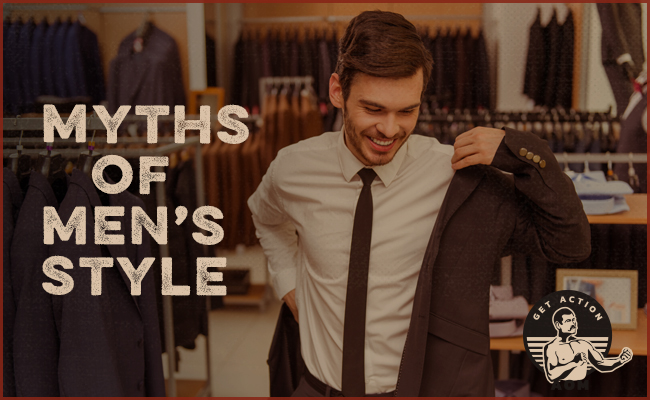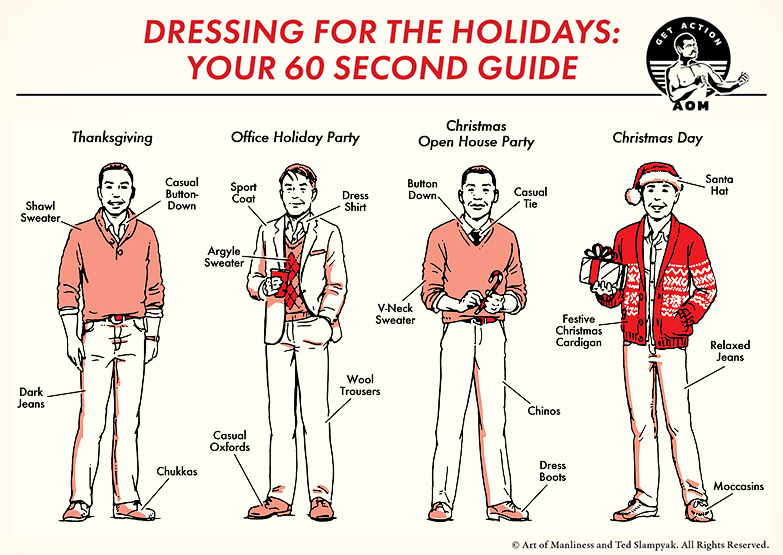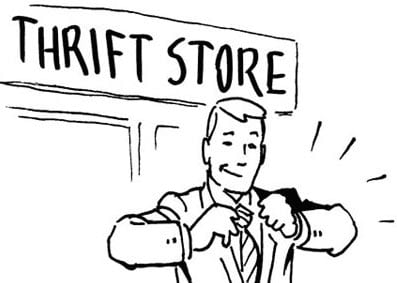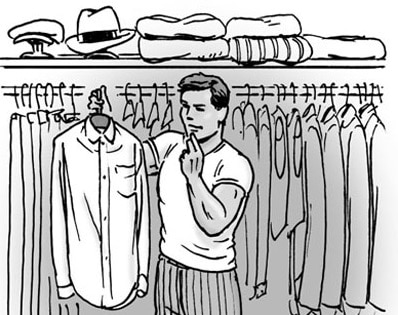When it comes to style, a lot of guys hold onto a handful of myths as excuses for not upping their game. Below, we debunk 8 of those most common myths and eliminate your excuses for schlubbing around town in baggy old jeans and a ratty hoodie.
1. You’ve always got to stay on top of the latest trends.
Trends are set by a lot of people, and can spontaneously arise. But the vast majority originate in a marketing firm somewhere.
Whether you’re seeing it on the front of Esquire, on a mannequin at Brooks Brothers, or in a Hollywood blockbuster, “this season’s look” exists because clothing manufacturers want you to buy clothes all year round, every year.
There are a couple problems to following marketed trends. The first is, obviously, cost — most of us don’t have the luxury of investing in a new duds every few months.
A second major problem is that “trends,” by definition, have to be recognizable. This means that fashion designers work to include unique, striking traits, ranging from unusual colors or patterns to very severe modifications on traditional cuts for menswear. These “different for the sake of being different” styles tend not to catch on over the long haul, and when the fashion fades, you’re left with a garment that’s just weird-looking instead of “in.”
Finally, trendy clothes are made to become quickly obsolete. They’re rarely built to last, since the assumption is that the wearer will replace them within a year or two. You’re not only getting a bad deal, but contributing to needless waste as well.
A better alternative is to buy sturdy, high-quality clothing made and tailored in a classic, enduring style without any experimental flourishes. Not only will this allow you to buy clothes less frequently, but those you add to your wardrobe can last for years, and even decades, without ever going out of style.
2. You need a great body to look good.
Being super-ripped looks great on the beach, but that doesn’t matter much, as the vast majority of our lives is spent clothed. And in point of fact, serious athletes and bodybuilders may actually have a harder time looking good in normal business clothes, since most garments you’d buy at department stores won’t be cut for their exaggerated proportions.
That’s not to say that a man should neglect his health or be unmindful of his body’s appearance, obviously. But sharp dressers throughout the years have included men of every shape and size conceivable. In many cases, Hollywood actors (who often have to change their body dramatically for different roles) have gone through a whole range of body types while staying consistently well-dressed.
The key to looking good lies in knowing what kind of clothes suit your body type: skinny men with slim limbs may want more bulk, broad men with a lot of weight in the midsection will want slimming styles, and so on.
Plus, good tailoring is a powerful equalizer. Men who aren’t confident in their physical appearance can change their appearance significantly with a well-tailored, well-fitted suit. A good jacket tends to make the shoulders look broader and the waist slimmer — the same look lots of guys hit the gym to achieve.
Of course, it’s always best to do both. Dress well and stay healthy and you’ll never have to worry about appearances. But don’t buy into the idea that you have to look good naked before it’s worth trying to look good clothed.
3. People are smart enough to judge your character, not your looks.
As noble as the idea of being judged solely on your merits is, it’s just not the reality in most situations.
People often have to make decisions about you long before they’ve had time to judge your character — and in those situations, it’s going to be your appearance they default to for guidance. We’re a very visual species and our brains make a lot of snap decisions based on what looks appealing or threatening to us.
As a result, your appearance is always sending messages to other people. A deliberately neglectful style — unkept hair, baggy jeans, and old T-shirts, among other things, tend to say, “I don’t care what you think about me.”
That appeals to some guys. And that impulse is reasonable. We’d all like to be rewarded based on our merits alone. But the look still says, “I don’t care,” and that makes people not want to do business or socialize with you. Why would they? You’ve already told them you’re not interested in their opinions, without saying a word.
Good dressing will always be important, no matter how impeccable your character or impressive your achievements. You don’t have to believe that better clothing makes someone a better person, but you do need to be aware of the influence your appearance has before you ever get a chance to open your mouth.
4. Dressing sharp takes longer than just throwing on any old thing.
Surprisingly, it actually gets easier and easier to dress in the morning as your clothing improves.
There are a couple of reasons for this. One is, obviously, that your options expand over time, assuming that you’re buying clothes faster than you’re wearing them out (not hard to do if you’re buying quality clothing). The more things you have in the closet that really suit you, the quicker it is for your tired, blurry eyes to latch onto something they like. Grab it, put it on, and go.
A man who’s thinking about his dressing also tends to build a more interchangeable wardrobe. If you’re a careful shopper you can amass a collection of shirts, pants, and accessories that work together, so that there’s never a moment where you’re saying, “I like this shirt/suit/whatever but don’t know what to wear it with.”
A man whose clothing doesn’t really suit him, on the other hand, is likely to spend a lot of time trying to put something decent together when he does need to dress up. That can become a long and frustrating morning routine if you’ve got to dress nicely for work every day and haven’t taken the time to build a wardrobe suited to your body and tastes.
Of course, a little judicious pruning here and there always helps. Once or twice a year it’s worth going through the closet and drawers and pulling out anything that you don’t really care for anymore, or that doesn’t fit, or that you just haven’t worn in a year or two. Give these discards away to charity. It’s that much less visual clutter when you’re deciding what you want to put on.
5. Ready-to-wear clothing is ready to go as soon as you get it off the rack.
Ready-to-wear or off-the-rack (two phrases for the same thing) clothing is made to fit as many people as possible. The less sizes the manufacturer has to make, the cheaper production costs are, so every size will be made pretty loose in the hopes of fitting more customers.
The result of this is that most ready-to-wear clothing requires adjustment. Unless you happen to have the exact measurements the machine was set for when it made the garment (highly unlikely), there are bound to be a few spots that don’t quite fit you.
Sleeves and cuffs often need adjusting, and shirts and jackets may need to be taken in at the waist for skinny men. Many places that sell higher-end ready-to-wear clothing will do adjustments in-house on things like suits and wool slacks. Men who order online may need to take items in to a tailor for final adjustments after they arrive.
So despite the name, “ready-to-wear” usually isn’t. T-shirts, jeans, and other casual clothes will probably be fine, but anything you want to look sharp in will need some adjusting.
6. Rack sizes are consistent.
This one is a novice shopper’s mistake. Anyone with a bit of fitting-room experience can tell you that one brand’s 36″ waist does not necessarily fit the same as another brand’s.
That’s largely because rack sizes only give a few basic measurements that can’t hope to describe the actual fit of the body. Trousers are a good example: for men, they’re almost always measured with either the waist size followed by the inseam length or just the waist size, sometimes accompanied by a word like “long” or “regular.”
What that describes is how long the trousers are and how they’ll fit around your belly. What it doesn’t describe is how close the joining point of the crotch is to the waistband, how wide the openings of the legs are, how broad the seat is, and a dozen other measurements that make all the difference between “fits like a dream” and “perpetual wedgie.”
What does this mean in practical terms? Primarily, it means that if you find a brand that really does fit you, treasure it and buy plenty. It also means keeping an eye on misleading phrases like “slim fit” or “relaxed fit” when trying things on — these are usually indicators of the unlisted measurements like thigh and seat width, and if you like the brand you’ll want to keep in mind what fit you like as well as the number of your size.
Men buying made-to-measure or bespoke clothing will find a whole host of new measurements beyond the rack size. It’s worth saving them for reference when you’re buying off-the-rack, so hang onto the numbers (when you buy new tailored clothing the tailor will, of course, take new measurements).
7. Dressing well costs a lot of money.
When it comes to making excuses for not dressing better, a lot of men will say that they’d like to, but just can’t afford it. They think style is an exclusive privilege of the well-heeled.
But style is obtainable no matter your income. It does take a little more effort to build a wardrobe on a budget — shopping at thrift stores, watching for sales, turning down trends, making your clothing last — but it’s doable. We’ve written plenty on this previously, so I’ll just point you to those resources:
- How to Look Like a Million Bucks for Under $50
- 10 Inexpensive Ways to Build Your Wardrobe
- Thrifting: 5 Tips for Getting Top-Quality Products at Rock-Bottom Prices
8. You can get all the knowledge you need from style writing.
As hard as we try, we can’t replace the value of experience. If knowledge were the only power, librarians would rule the world. There comes a point where you just have to get out there and experiment for yourself.
That doesn’t mean you shouldn’t do your reading first — but it does mean that the best way to get good at buying clothes is to buy some clothes. See what you like and what you don’t. Learn your tastes, your body size, and your tolerance for shopping. Make a few mistakes (we all do).
A lot of looking good comes down to plain old confidence. You get that by becoming comfortable with your wardrobe and your style choices. It comes over time. Style blogs, books, and magazines are great starting places that can give you an idea of where you want to go.
Then it’s up to you to actually go there.
______________________________
Written By Antonio Centeno
Founder, Real Men Real Style
Click here to grab my free ebooks on men’s style








